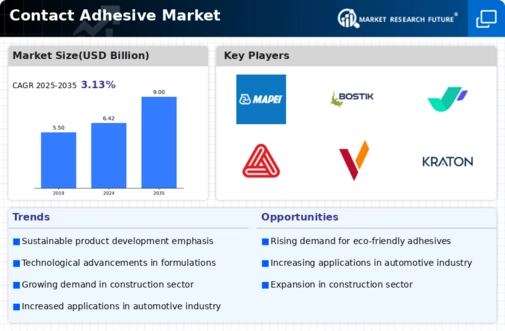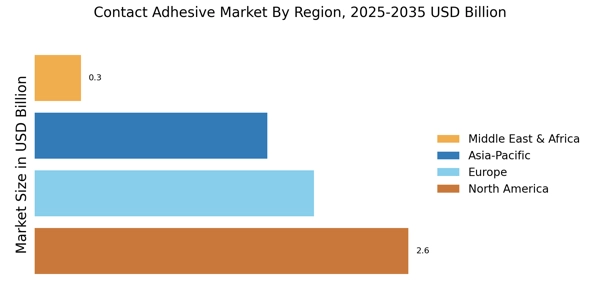Automotive Industry Growth
The automotive sector plays a pivotal role in the Contact Adhesive Market, as the demand for lightweight and durable materials continues to rise. With the automotive industry projected to grow at a rate of around 4% annually, the need for effective bonding solutions is becoming increasingly critical. Contact adhesives are utilized in various applications, including interior assembly, exterior bonding, and component attachment. The shift towards electric vehicles and advanced manufacturing techniques is likely to further propel the demand for specialized adhesives that meet stringent performance criteria. Consequently, the Contact Adhesive Market is expected to benefit significantly from the automotive sector's expansion.
Rising Construction Activities
The Contact Adhesive Market is experiencing a notable surge due to the increasing construction activities across various sectors. As urbanization continues to expand, the demand for adhesives in residential, commercial, and industrial construction is on the rise. In 2025, the construction sector is projected to grow at a compound annual growth rate of approximately 5.5%, which directly influences the consumption of contact adhesives. These adhesives are essential for bonding materials such as wood, metal, and plastics, which are prevalent in construction projects. Furthermore, the trend towards prefabricated construction methods is likely to enhance the demand for high-performance adhesives, thereby driving the Contact Adhesive Market forward.
Expansion of the Packaging Industry
The packaging industry is another critical driver for the Contact Adhesive Market, as the demand for efficient and reliable bonding solutions continues to rise. With the packaging sector projected to grow at a rate of approximately 4.5% annually, the need for contact adhesives in various applications, including flexible packaging and labeling, is becoming increasingly apparent. These adhesives are essential for ensuring product integrity and enhancing shelf life. As consumer preferences shift towards convenience and sustainability, the Contact Adhesive Market is likely to see increased demand for adhesives that meet these evolving needs, thereby fostering growth in the packaging sector.
Increased Demand in Furniture Manufacturing
The furniture manufacturing sector is a key driver for the Contact Adhesive Market, as the demand for innovative and durable furniture solutions continues to rise. In recent years, the furniture market has shown a steady growth rate of approximately 3.5%, which correlates with the increased use of contact adhesives in the production process. These adhesives are essential for ensuring strong bonds in various materials, including wood, laminates, and composites. As manufacturers seek to enhance product quality and reduce production times, the reliance on efficient bonding solutions is likely to increase. This trend suggests a robust future for the Contact Adhesive Market, particularly in the context of furniture production.
Technological Innovations in Adhesive Formulations
Technological advancements in adhesive formulations are significantly influencing the Contact Adhesive Market. Innovations such as the development of low-VOC and eco-friendly adhesives are becoming increasingly important as regulatory standards tighten. The market for these advanced formulations is expected to grow, driven by consumer preferences for sustainable products. In 2025, the demand for environmentally friendly adhesives is projected to account for a substantial portion of the overall adhesive market. This shift towards innovative formulations not only enhances performance but also aligns with the growing emphasis on sustainability within the Contact Adhesive Market.


















Leave a Comment